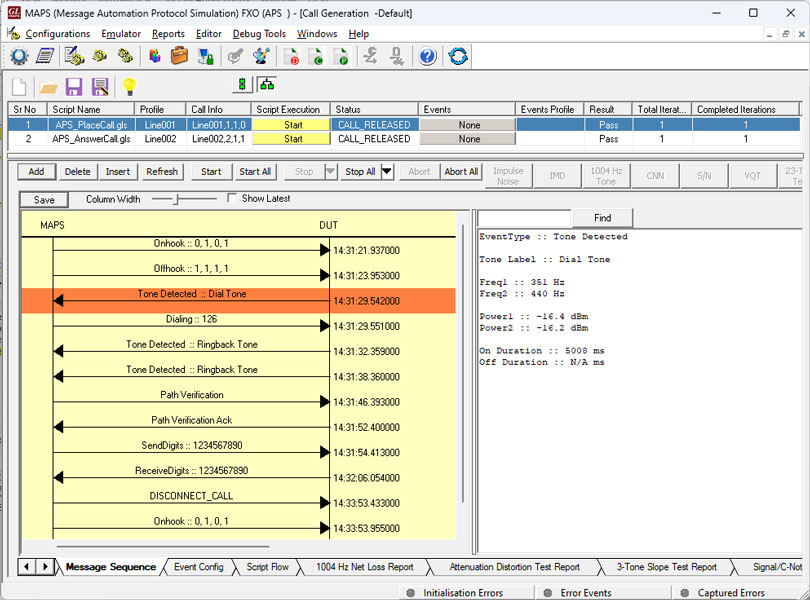High-Density Analog Call Simulation and Automated Protocol Testing for Telecom Networks
Welcome to the latest issue of GL's Newsletter, offering insight into our high-capacity analog 2-Wire FXO/FXS or 4-Wire E&M bulk call generator used to test a Central Office, PBX, Analog Telephone Adapter, Optical Network Terminal/Optical Line Terminal, Gateways, and other telecommunications equipment.

Overview
GL's Message Automation & Protocol Simulation (MAPS™) is a versatile software program that can emulate a wide variety of telecommunications protocols. The MAPS™ Analog Phone Simulator (APS) is a high capacity analog 2-Wire FXO/FXS or 4-Wire E&M Bulk Call Generator that tests telecom network infrastructure such as the Central Office, PBX, Analog Telephone Adapter (ATAs), Gateways and other devices.
Hardware, Software, and Automation Capabilities
MAPS™ APS includes server hardware, GL MAPS™ software, and channel banks, along with optional modules for fax emulation and voice quality testing analysis, all in a compact rack-mount system. The MAPS™ APS system supports up to 96 independent FXO or FXS ports per 1U MAPS™ APS/ALS server. MAPS™ APS also supports automation with a Command Line Interface and external control through Application Programming Interfaces (APIs) for Python and Java.
Comprehensive Analog Features and Call Scenarios
GL’s solution supports a comprehensive range of analog features, including on-hook/off-hook, ringing signal detection, ring-back tone detection, dialing, and hook flash. It also accommodates various call scenarios, such as two-way calling, three-way conference calling, and three-way calling with caller ID. Additionally, it supports Visual Message Waiting Indicator (VMWI), call waiting, caller ID, flash to accept calls, and call forwarding, ensuring versatile and efficient communication capabilities.

FXO FXS Call Emulation
Automated Supplementary Service and IVR Testing Capabilities
MAPS™ APS supports comprehensive Supplementary Service Testing and Interactive Voice Response (IVR) testing. It can recognize and respond to voice prompts using either DTMF digits or voice commands, enabling automated traversal and testing of IVR systems. The solution offers high-density connectivity to any 2-Wire analog interface, facilitating fully automated and customizable testing processes.
Multi-Protocol Bulk Call Generation and Signaling
The MAPS™ platform provides automated, scripted, multi-user, multi-protocol, and high-capacity bulk call generation. It serves as the foundation for signaling protocols and traffic generation, accommodating various types of traffic including voice, tones, digits, fax, data, and video, depending on network support. MAPS™ encompasses legacy PSTN, TDM, SONET SDH, next-generation VoIP, and wireless protocols, interfaces, and equipment. In TDM networks, MAPS™ supports a wide range of signaling protocols for establishing links, including CAS, FXO/FXS, ISDN, SS7, PPP, GSM, INAP, CAP, and MAP.
Automated Voice Quality Testing
The GL MAPS™ APS solution works with GL's Voice Quality Testing (VQT) software, which uses POLQA (versions 2 and 3) and PESQ algorithms. POLQA is best for analyzing HD audio in wideband IP networks. The VQT software automates the testing process, logs results to a central database, and allows access via web-based client for voice and data quality testing - GL’s WebViewer™.
Key Features
- Test the Central Office, PBX, Gateway, Analog/Digital/VoIP networks
- Test Optical Network Terminal/Optical Line Terminal
- Test Gigabit Passive Optical Network (GPON OLT) units using MAPS™ APS as an FXO emulator
- Manual and automated bulk analog call simulation
- Call monitoring and call recording
- IVR using GL Speech Transcription Server
- API support (Python, Java) for integration with automation frameworks
- Supports E&M (Type I, II, III, IV, V) signaling - immediate start, wink start, delay start
FXO Capabilities- Subscriber Call Generator
- Up to 96 independent subscriber FXO ports per 1U MAPS™ APS
- Supported Call Scenarios:
- Caller ID
- Two-way Calling
- Three-way Conference Calling
- Three-way Calling with Calling Party Number ID
- VMWI – Voice Mail with MWI (Message Waiting Indicator) and SDT (Stutter Dial Tone)
- Call Waiting – Detect tone, Call ID, Flash to accept call
- Call Forwarding
FXS Capabilities:
- Up to 96 independent FXS ports per 1U MAPS™ APS
- Central office simulation with two-way calling
- User-programmable call progress tone generation for different countries/regions:
- Dial tone
- Ringback tone
- Busy tone
- Reorder tone
- Howler tone (extended off-hook signal)
- Ring generation with programmable ring cadence
Reporting:
- Pass/Fail Status
- Failure details, etc.
- Call failure/Call completion events
- Call drop (sustain calls) events
- Voice Quality Test Mean Opinion Score scores
- Delay measurements (one-way delay, post-dial delay)
- Supports PDF and CSV file formats
Voiceband measurement capabilities for VG3 and VG6:
- 1004 Hz Net Loss test
- Twenty-Three Tone test
- Attenuation Distortion (304-3004 Hz, 404-2804 Hz, and 504-2504 Hz) test
- Three Tone Slope (Gain Slope) test
- Signal/C-Notched Noise Level test
- Intermodulation Distortion (IMD) test
- Impulse Noise test
- Signal-to-Noise Ratio and Level test
- Voice Quality Test
 Back to Newsletter Index Page
Back to Newsletter Index Page